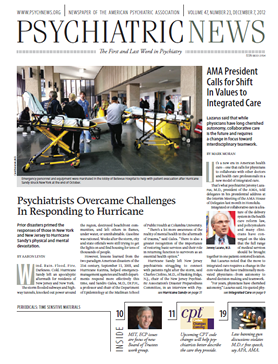Forensic psychiatry must keep expanding and deepening its evidence base, and its practitioners must recognize and reduce bias in their work, said Charles Scott, M.D., the outgoing president of the American Academy of Psychiatry and the Law, in an address at the organization’s annual meeting in Montreal in October.
In 2005, the National Academy of Sciences (NAS) issued a report criticizing the status of forensic science in the United States. The report called for improved reliability, enforceable standards, and use of best practices. The NAS’s overall conclusion: “Research is desperately needed.”
However, the report barely mentioned forensic psychiatry, said Scott, a professor of clinical psychiatry and director of the forensic psychiatry residency program in the Department of Psychiatry and Behavioral Sciences at the University of California, Davis.
“We were in the book, but we were not well defined,” he said. To better define itself as a science, therefore, forensic psychiatry must continue its balance of clinical and actuarial methods of evaluating patients.
The two guiding principles of forensic psychiatry should be a commitment to subjective and objective truth telling, with the latter consistent with the standards of science, he said. That commitment must also be balanced with a regard for the rights and dignity of the person being evaluated.
“We want and need our voices to be heard, so we need science to go along with clinical judgment,” said Scott. “Reliable scientific methodology allows accurate analysis of evidence.”
Risk-assessment instruments are an important component of research because they provide a structured way to gather and evaluate information, he noted. However, more research on the instruments used to assess risk is essential, especially now that statutes and regulations are beginning to require structured evaluations of psychopathology in assessing criminal defendants.
Many tests were devised as research tools and work well with populations, but are less predictive when used with individuals, said Scott. Further research could sift out and define a more limited number of instruments that are appropriate, practical, and meet ethical standards.
Understanding these tools and their interpretation would also improve the forensic psychiatrist’s ability to review evidence and evaluate other experts’ analyses.
As questions about the validity and utility of these tools are refined, psychiatrists will need more training to keep up their skills. If they have not already done so, forensic psychiatrists should take on the task of learning how to administer and evaluate these tools, to determine both initial risk assessment and readiness for release after treatment, he said.
But improved methodology alone is not enough, Scott stated. “We also have to train forensic psychiatrists to check their own biases.”
He cited four ways in which an evaluator’s judgment could be unconsciously influenced.
Anchoring bias can add extra weight to the earliest evidence gathered in a forensic examination, he said. Confirmation bias can let an a priori conclusion about the subject cloud the evidence-gathering process. Attribution bias can be any factor irrelevant to the examination (such as race or physical attractiveness) that can influence the evaluator’s judgment. Finally, observer bias is a condition, like fatigue or the time of day, that affects decisions.
“However, just being aware of biases doesn’t prevent bias,” Scott emphasized. Additional training in recognizing and dealing with bias is essential for both fellows and experienced practitioners.


